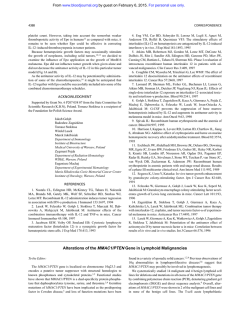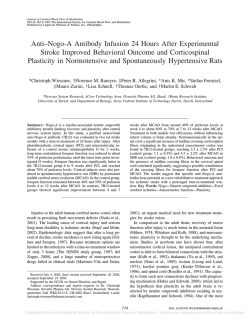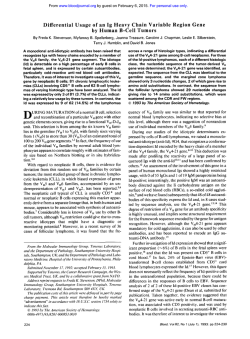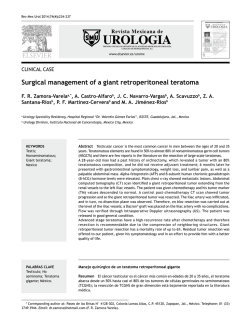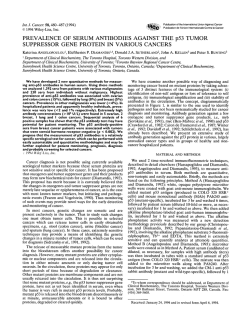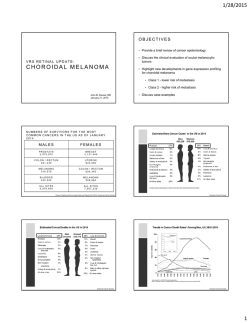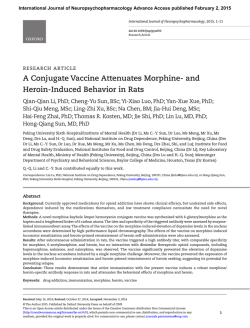
Phase I Clinical Trial Using Escalating Single-Dose
From www.bloodjournal.org by guest on February 6, 2015. For personal use only. Phase I Clinical Trial Using Escalating Single-Dose Infusion of Chimeric Anti-CD20 Monoclonal Antibody (IDEC-C2BS) in Patients With Recurrent B-Cell Lymphoma By D.G. Maloney, T.M. Liles, D.K. Czerwinski, C. Waldichuk, J. Rosenberg, A. Grillo-Lopez, and R. Levy The B-cell antigen CD20 is expressed on normal B cells and by nearly all B-cell lymphomas. This nonmodulating antigen provides an excellent target forantibody-directedtherapies. A chimeric anti-CD20 antibody (IDEC-C2B8), consisting of human IgG1-K constant regions and variable regions from the murine monoclonal anti-CD20 antibody IDEC-2B8,has been produced for clinical trials. It lyses CD20' cells in vitro via complement and antibody-dependent cell-mediated lysis. Preclinical studies have shown that the chimeric antibody selectively depletesB cells in blood and lymph nodes in macaque monkeys.In this phase I clinical trial, 15 patients (3 per doselevel) with relapsed low-grade B-cell lymphoma were treated with a single dose (IO, 50, 100. 250, or 500 mg/m2)of antibody administered intravenously. Treatmentrelated symptoms correlated with the number of circulating CD20 cells and grade II events consistedof fever (5patients), nausea (2), rigor (2). orthostatic hypotension (2). bronchospasm (l),and thrombocytopenia (1). No significant toxici- ties were observed during the 3 months of follow-up. Serum C3, IgG, and IgM levels, neutrophils, andT cells were largely unchanged. At thethree higher dose levels, pharmacokinetics of the free antibody showed a serum half-life of 4.4 days (range, 1.6 t o 10.5).Levels greaterthan 10 pg/mL persisted in 6 of 9 patients for more than 14 days. No quantifiable immune responses t o the infused antibody have been detected. CD20+ B cells were rapidly and specifically depleted in the peripheral blood at 24 t o 72 hours and remained depleted for at least 2 to 3 months in most patients. Two-week postinfusion tumor biopsies showed the chimeric antibody bound t o tumor cells anda decrease in the percentage of B cells. Tumor regressions occurredin 6 of 15 patients (2 partial and 4 minor responses). The results of this single-dose trial have been used t o design a multiple-dose phase 1/11 study. 0 1994 by The American Societyof Hematology. T 1 e ~ e l .Two l ~ trials have been reported using anti-CD20 radioimmunoconjugates. Bone marrow ablative doses of I3'I-conjugated B1 (IgG2a murine MoAb anti-CD20) resulted in complete remissions in 84% of patients.I4 The use of nonmarrow-ablative doses also resulted in partial and complete remissions inthemajority of patient^.'^ In both of these trials, antitumor effects were observed during the imaging portion of the trials when trace doses of radiolabeled MoAbs were infused with large amounts of unlabeled antibody, suggesting that the murine anti-CD20 MoAb itself may be contributing to the antitumor effect. Indeed, the relative contributions to the antitumor effect of the targeted radiotherapy, of the cold antibody, and of the nonspecificwholebody radiation delivered by the radioimmunoconjugates is difficult to Murine MoAbs have several potential limitations when used in clinical trials. Genetic manipulation has made it possible to engineer chimeric antibodies with murine binding HE TREATMENT OF patients with relapsed non-Hodgkin's lymphoma (NHL) remains a frustrating problem. More than 50% of patients with aggressive lymphomas and the majority of patients with low-grade lymphomas are not cured by current therapies. New treatments with different mechanisms of action and toxicity profiles are needed. Previous work using patient-specific anti-idiotype monoclonal antibodies (MoAbs) has shown that NHLs are accessible to intravenously infused antibody, and that tumor regressions, including durable complete remissions, can be induced in some patient^.'.^ With current technology, because of the difficulty and time required to produce patient-specific antibodies, this approach is not feasible for general application. In contrast, the antigen CD20, a 32-kD nonglycosylated phosphoprotein present on the surface of nearly all B cells provides a more universal target for imm~notherapy.~ CD20 is expressed on the surface of normal B cells from the time of cytoplasmic pH chain expression throughout differentiation until the antibody-secreting plasma cell stage. Importantly, it is notexpressed on early pre-B cells, stem cells, or antigenpresenting dendritic reticulum cells5 More than 90% of Bcell NHLs express this surface protein."' It is also expressed at a lower density on B-cell chronic lymphocytic leukemia.' Although the function of this molecule isnot completely defined, it may aggregate and function as a calcium channel.' Antibodies binding to surface CD20 can induce a transmembrane signal" that can cause a variety of effects from cell activation to blocking cell cycle progression and differentiation.".'2 The CD20 protein has multiple trans-membrane domains and does not modulate from the cell surface in response to antibody binding and thus provides an ideal target for immunotherapeutic strategies not depending on internalization for their antitumor effect. Unconjugated murine MoAbs to CD20 have been used for immunotherapy. A trial of the 1F5 murine IgG2a anti-CD20 MoAb in four patients showed antitumor activity with minimal toxicity at the highest dose Blood, Vol 84, No 8 (October 15). 1994 pp 2457-2466 From theDepartment of Medicine, Division of Oncology, Stanford University Medical Center, Stanford, CA; and IDEC Pharmaceuticals, San Diego, CA. Submitted February 9, 1994; accepted June IO, 1994. Supported in part by Grant No. CA34233 from the US Public Health Services, National Institutes of Health. D.G.M. is supported by a Clinical Associate Physician Award from the General Clinical Research Center. R.L. is an American Cancer Society Clinical Research Professor. Address reprint requests to D.G. Maloney, MD, PhD, Stanford University, Department of Medicine, Division of Oncology, SUMC M207, Stanford, CA 943055306, The publication costs of this article were defrayed in part by page charge payment. This article must therefore be hereby marked "advertisement" in accordance with 18 U.S.C. section 1734 solely to indicate this fact. 0 1994 by The American Society of Hematology. 0006-4971/94/8408-0013$3.00/0 2457 From www.bloodjournal.org by guest on February 6, 2015. For personal use only. 2458 MALONEY ET AL sites and humanconstant regions that havelower immunogenicity, longer half-life, and are able to lyse tumor cells using human complement or antibody-dependentcell-mediated cytotoxicity (ADCC) effector cells more effectively than the murine MoAb.'*-*'' Achimeric anti-CD20 antibody has been producedthat contains theheavy and lightchainvariable regions from a murine IgCl monoclonal anti-CD20 antibody (IDEC-2B8) and human IgCl K constant regions." Stable, high-level expressionwas obtained by transfection of the relevant gene constructs into Chinese hamster ovary (CHO) cells. In vitro studies showed similar binding characteristics betweenthe chimericand murine anti-CD20antibodies; however, the chimeric antibody was ableto lyse CD20+ B cells using human complement or human effector cells (ADCC) 1,000-fold more effectively than the murine antibody. Preclinical studies in macaque cynomolgus monkeys haveshownthatrepeated doses of thechimericantibody depletedaround 80% of CD20' B cells intheperipheral blood, lymph nodes, spleen, and bone marrow, with gradual recovery over a period of several months." No toxicity was observed in these studies. We describe here the first phase 1clinical trial of single-dose infusion with the chimeric antiCD20 antibody (IDEC-C2B8) in patients with relapsed Bcell NHL. MATERIALS AND METHODS Chimeric monoclonal anti-CD20 antibody. The chimeric monoclonalanti-CD20antibody(IDEC-C2B8) has beenproducedand provided for clinical trialsby IDEC Pharmaceuticals CO (San Diego, CA) and supplied under an Investigational New Drug Application. Protocol design. This was a phase I clinical trial of single-dose IDEC-C2B8chimericanti-CD20MoAbadministeredtopatients with relapsed B-cell NHL. Detailed informed consent was obtained from all patients in accordance with the human subjects institutional review board of Stanford University Medical Center. Three patients were treated at each dose level with a single intravenous infusion of IO, 50, 100,250,or 500 mglm' of MoAb. Patients were evaluated for infusional related toxicity and effect on peripheral blood B cells, T cells, neutrophils and platelets, serum chemistries, Ig, and complement levels. In patients treated at the upper three doses, tumor biopsies were obtained 2 weeks after treatment and examined for evidence of antibody binding and B- and T-cell content. All patients were evaluated for antitumor activity. Patient selection. On entry to the study, patients were required to have relapsed NHL with measurable disease after at least one prior course of standard therapy. A tumor biopsy was performed to document tumor cell expression of the CD20 antigen and reactivity withIDEC-2B8orIDEC-C2B8antibodiesusing flow cytometry. In addition, baseline hematologic function (1,500 granulocytes and 50,000 platelets/pL), renal function (serum creatinine of <2.5 mg/ dL), quantitative serum IgG of greater than 600 mg/dL, a negative serology to human immunodeficiency virus, a negative hepatitis B surface antigen, and a life expectancy of at least 3 months without to otherseriousillnesswasrequired.Patientspreviouslyexposed murine antibodies were required to have no evidence of a pretreatment human antimurine antibody immune response (HAMA). Flow cytometty. CD20antigenexpression was determinedon all cases before antibody treatment by flow cytometry of fresh or cryopreserved tumor cell suspensions. Tumor cells were obtained from excisional biopsies or from fine needle tumor aspirations and stained for CD20 expression with fluorescein isothiocyanate (FIT0 conjugated IDEC-2B8 or IDEC-C2B8 (IDEC Pharmaceuticals) and Leu-16. an independent anti-CD20 antibody (Becton Dickinson. San Jose, CA). Tumor cells were also analyzed for expression of surfacc Ig light chains[FITC-goatF(ab)?-antihuman K or X; T a p . Burlingame,CA).CD19,CD4,CD3,CD8 (FITC- orphycoerythrin [PE]-conjugated Leul2, L e d , Leu4, and Leu2; Becton Dickinson). and CD37 (MBI clone 6A4). Peripheral blood samples were anaIyLed for the number of cells expressing the CD20 antigen using two-color flow cytometry using PE or FITC conjugates of the above reagents Two-week posttreatment tumor biopsies were also evaluated for B-andT-cellcontentusingthesamereagentsdescribedabove. Antibodyboundtotumorcellsfrom in vivoadministration was detected by acombination of twodifferentmethods. In the first method, cells were stained using FITC-labeled anti-CD20 antibodies. The presence of the unlabeled antibody blocked the binding of the labeled antibody, resulting in decreased immunostaining of the Bcell tumor population (as identified using antibodies to additional B-cell antigens CD19, CD37, IgM, IgG, K or X). Second, the bound chimeric antibody was detected directly by looking for IgM K - or X-positive tumorcells now bearingthehuman IgG ( K ) constant regions of the chimeric antibody (IDEC-C2B8) using an FITC-laheled goat F(ab)> antihuman IgG y-chain-specific reagent (Tago). An estimate of the percentage of tumorcells with the chimeric antibodyattachedwasobtained by comparingthestaining of the pretreatment and the posttreatment biopsies for human IgG constant regions. IUEC-C2BSpharmacokinetic.s. Serum levels of the chimeric antibody were determined using anenzyme-linkedimmunosorbent assay (ELISA). Microtiter plates were coated with a purified polyclonal goat anti-IDEC C2B8 idiotype antiserum. After washing and blocking, posttreatment sera were serially diluted. Bound human IgG was then detected using a horseradish peroxidase (HRP)-conjugated polyclonal antihuman IgG reagent, and the plates developed with the substrate 2,2-a~inobis(3-ethylbenzthiazoline sulfonic acid) (ABTS). Antibody concentration was determined by comparison of the signal from the patients sera with that obtained from known concentrations of purified chimeric antibody diluted into normal human serum. Measurement I$ host anti-IDEC C2B8 antibody response. Posttreatment sera from evaluations at l,2, and 3 months were analyzed for evidence of a host antichimeric antibody immune response using a sandwich ELISA with microtiter plates coated with IDEC C2B8, the murine antibody 2B8, or normal murine IgG. Dilution's of the patients sera were added and, after washing, detected with biotinlabeled IDECC2B8followed by Avidin-HRPand the substrate ABTS. This assay has a level of quantification of 5 pg/mL. Studv measurements. Patientswereevaluatedforinfusional related toxicity using the National Cancer Institute's Common Toxicity Criteria.Hematologic,renal,andhepaticfunctionwasmonitored before and after infusion and duringmonthly intervals after therapy. Sera for evaluation of antibody levels and pharmacokinetics, serum IgG and IgM levels, and CD20 expression on peripheral blood B cells was obtained at eachfollow-upvisit.Tumor response was assessed by evaluation of tumor measurements fromphysical examination and from radiologic imaging studies. For 3 months after therapy, patients were evaluated at monthly intervals and then followed at 1- to 3-month intervals until disease progression was observed. A complete remission (CR) required complete resolution of all detectabledisease.A partial remission(PR)requiredagreater than 50% reduction in measurable disease persisting more than 30 days. A minor response (MR) was defined as a 25% to 50% reduction in disease. Stable disease (SD) was defined as no significant change in tumor measurements without progression over the period of observa- From www.bloodjournal.org by guest on February 6, 2015. For personal use only. ANTI-CD20 ANTIBODY THERAPY FOR B-CELL LYMPHOMA 2459 Table 1. Patient Characteristics Patient No./Sex/Age FM 001lMl53 FSC 002/M/55 003N149 Dose (mad) Tumor Histology Stage" 111 10 111 10 10 DlLD (mantle zonel MACOP-B Prior Therapy Splenectomy C-MOPP m-BACOD CHOP XRT (total nodal) CVP Chl IV Disease Bulkt Maximal Response +++ Leukemia + Delayed PR? Leukemia Splenomegaly ++ Chl Anti-Id (MoAb) CVP 004N163 DLCFSC 50 FSC 005N161 50 006F159 50 007F158 100 IV FM 111 SL IV DLC, monocytoid B cell IV 008lMi73 100 FM IV 009lMl65 100 FM IV 0 1OlMI38 250 FSC (diffuse areas) IV 0111M146 250 DLID (mantle zone) IV CVP Id-Vac ProMACEICytaBOM XRT anti-Lym-l (MoAb) ChMP CVP CVP CVP CVPIBVP MACOP-B XRT XRT Chl anti-CD4 (MoAb) ChlIP Splenectomy Chl Velban CVP Anti-Id (IFN) Anti-Id (Chll MINWSHAP 9 ~ ~ 1 CVP + Mixed ++ +++ + PR Splenomegaly ++ MR ++ Mixed ++ Splenomegaly +++ MR Splenomegaly 0 121F152 250 FSC 013lMl48 500 FM 0 14Fl65 FM 500 015ffE.8 FSC 500 MR CHOP IV CHOPIXRT C hIIP Chl/P VACOP-B Fludarabine IFN IVb CHOP DHAP CVP gOy-Bl IV IV Ctx ProMACENOPP XRT IFN +++ + + MR + PR Abbreviations: FSC, follicular small cleaved cell; FM, follicular mixed small and large cell; DLID, diffuse lymphoma intermediate differentiation; DLC, diffuse large cell; SL, small lymphocytic; XRT, radiation therapy; IFN, interferon a;ProMACElMOPP, etoposide, cyclophosphamide, adriamycin, methotrexate, prednisone, nitrogen mustard, vincristine, and procarbazine; ProMACHCytaBOM. cyclophosphamide, adriamycin, etoposide, prednisone, cytarabine, bleomycin, vincristine, and methotrexate; Ctx, cyclophosphamide; CHOP, cyclophosphamide. adriamycin, vincristine, and prednisone; CVP, cyclophosphamide, vincristine, and prednisone; 9 - 6 1 . ytriumlabeled B1 (antLCD20MoAb); DHAP, cisplatin, cytarabine, and decadron; VACOP-B, VP-16, adriamycin. cyclophosphamide, vincristine, prednisone, and bleomycin; Chll P, chlorambucil and prednisone; MINE-ESHAP, ifosphamide, novantrone, etoposide, platinum, and cytarabine; Anti-Id, anti-idiotype MoAb; Id-Vac, ldiotype vaccination; BVP, bleomycin, vincristine, and prednisone; Mixed, regression noted in some but not a11 areas. Clinical stage at disease diagnosis. t Tumor bulk estimated from physical exam and CT scans of thechest, abdomen, and pelvis and graded as follows: multiple areas of adenopathy with largest mass <5 cm (+), nodal mass >5 cm (++), extensive disease with multiple areas 2 5 cm ( + + + h From www.bloodjournal.org by guest on February 6, 2015. For personal use only. 2460 MALONEY ET AL Table 2. Infusional-Related Symptoms During Chimeric Anti-CD20 Antibody Therapy Patient Dose Dose given No. (mglm') (mg) Pre Rx CD20 (cells/@L) 00 1 10 16 1,630 (tumor) 002 10 22 960 (tumor) 003 004 005 006 007 008 009 010 01 1 012 013 10 50 50 50 100 100 100 250 250 250 500 21 100 100 90 180 188 1,200 50 60 40 140 130 50 580 (normal 90 130 20 60 014 015 500 500 965 760 200 520 575 400 130 160 Toxicity B) Fever, rigor, bronchospasm Fever, rigor, nausea None Fever Fever, chill Myalgia Fever Fever Fever, rigor Chill Fever, headache Fever Fever orthostatic hypot. nausea Fever, nausea Fever, nausea, headache lymphoma. One patient had an initial diagnosis of a diffuse large-cell lymphoma; however, a relapsed node biopsy showed a monocytoid B-cell histology. Two patients with an initial diagnosis of a low-grade lymphoma had histologic progression on tumor biopsies performed before antibody therapy (1 follicular large cell and 1 diffuse large cell). The majority of patients (12/15) presented with stage IV disease. Patients had lived with their disease a mean of 5 years (range, 1.7 to 9.5) at the time of antibody therapy. All patients had measurable progressive disease and had received a median of two prior regimens (range, 1 to 5 ) of conventional therapy within the past 1.5 years. Five patients had previously been treated with murine MoAbs, including 2 patients who had received radiolabeled anti-CD20 antibody therapy ( I with a short PR and 1 with no response). All patients previously exposed to murine antibodies were HAMA-negative at the time of treatment. Infusional-related toxicity. All patients completed the planned antibody infusion. Infusional-related symptoms are detailed in Table 2. The most frequent side effect was lowgrade fever, which was seen in 13 of 15 patients (grade I1 in 5/15). Three patients additionally developed rigors and 1 developed bronchospasm requiring transient administration of supplemental oxygen. One patient on multiple medications for high blood pressure developed orthostatic hypotension during the antibody administration. In all patients, the antibody infusion was temporarily discontinued when significant side effects were observed. If necessary, the patients were treated as indicated with diphenhydramine and acetaminophen. Antibody infusions were usually restarted within 30 to 45 minutes at 50 to 100 mg/h and then escalated as tolerated to 200 m@. No significant further toxicity except fever was observed in any patients during the remainder of the antibody infusion. Three of the 4 patients having more significant reactions were also noted to have thehighest levels of pretreatment CD20' cells in the peripheral blood (Table 2). Interestingly, these cells could be malignant (patients no. I and2) or normal (mixed K or h phenotype, as observed in patient no. 9). Effect on circulating B cells. In all patients, the numbers of B cells present in the peripheral blood before and after anti-CD20 therapy were analyzed using two-color flow cytometry. B cells were identifiedusing the B-cell antigens CD19 and surface Ig, neither of whichisblocked by the binding of the chimeric antibody to CD20. Bound antibody from in vivo administration was identified on the B cells by finding human IgC or K bound to B cells coexpressing IgM and h, or by the blocking of binding of a directly labeled anti-CD20 antibody. There was a dose-dependent. rapid, and specific depletion of the B cells in all patients, especially those receiving doses of morethan 100 mg. In allbut 1 patient receiving the higher doses (>50 mg/m2),these depletions persisted for I to greater than 3 months. The specificity of the B-cell depletion in a patient receiving 100 mg/m2 is shown in Fig 1. After intravenous administration of 180 mg of antibody, there was a rapid and complete disappearance of B cells expressing CD20, CD1 9, K , or h surface antigens. There was no effect on the number of T cells (CD3), and the decrease in the numbers of lymphocytes is accounted for entirely by the decrease in the numbers of B cells. Peripheral blood B-cell levels for the duration of the 3-month study are shown on all 15 patients in Table 3 . Three patients had circulating tumor cells, as shown by a clonal expansion of cells containing the same heavy and light chain isotype as identified on cells of their lymphomas obtained from tumor biopsies. Three patients had no detectable peripheral blood B cells at the 3-month evaluation. Follow-up is available 50 0 0 20 40 80 Days since Rx Fig 1. Depletion of peripheralblood B cells after 100 mg/mz chimeric anti-CD20 antibody. Patient no. 007 was treated with 100 m g l m* of chimeric anti-CD20 administered intravenously on day 1. Peripheral blood mononuclear cells were analyzed by flow cytometry for the expression of B- and T-cell antigens. There was a rapid and specific depletion of B cells, as indicated by the loss of cells expressing K or A light chains aswell as the &cell antigens CD19 and CD20. (m) Lym; IO) CD19; (AI CD20; (0) CD3; (A) K; IO) L. From www.bloodjournal.org by guest on February 6, 2015. For personal use only. ANTI-CD20 ANTIBODY THERAPY FOR B-CELL LYMPHOMA 2461 Table 3. Dwletion of B Cells From the Blood After Infusion of Chimeric Anti-CD20Antibody B-Cell Depletion Post-Rx CD19 Dose Patient No. (mglm’l 00 1 002 1,870 003 004 ,150 20 1 Pre Rx CD19 (cells/pL) 10 1,250 10 10 50 005 006 50 50 007 008 009 010 011 012 013 014 015 100 100 100 250 250 250 500 500 500 3 7 1,940 2,240 60 60 50 EO 140 40 600 90 140 d3 995 10 5 6 4 130 30 10 1 mo 2 mo 3 mo 1,260 ND ND ND 10 5 ND 1 80 20 1 9 0 165 3 5 10 1 wk 1 180 75 6 50 8 60 130 160 290 ND 90 40 8 110 60 10 6 130 0 ND 10 120 0 120 3 0 0 0 6 0 0 20 70 0 0 5 20 180 ND ND 4 7 0 Abbreviation: ND, not determined. for 1 patient showing a return of B cells 7 months after treatment. Serum antibody pharmacokinetics. Serum antibody was detected in all patients immediately after the intravenous infusion. Serum levels following 100, 250, and 500 mg/m‘ infusions are shown in Fig 2. In the 9 patients receiving 100 mg/m2 or greater, the mean half-life of the antibody was 4.4 days, with a range from 1.6 to 10.5 days. Antibody levels of greater than 10 pg/mL persisted in the serum of 6 of 9 patients for more than 14 days. In 3 of 6 patients treated with 250 mg/m’ or 500 mg/m2, antibody levels were detected 1 month after antibody therapy. In one case, the antibody half-life was 10.5 days and serum antibody, capable of binding to pretreatment tumor cells was present more than 1 month after treatment. One patient (patient no. 011) treated at the 250 mg/m’ dose had a large tumor burden with splenomegaly and a short half-life of the chimeric anti-CD20 antibody (1.6 days). IO00 Detection of host anti-IDEC-C2B8 immune response. Sera were analyzed at monthly intervals for the 3-month duration of the trial for evidence of an immune response. No quantifiable antibody responses were detected against the chimeric antibody, with a level of quantification of 5 pg/ d. Subsequent analysis of serum from 7 patients at various intervals to 1 year of follow-up were also negative. Analysis of posttreatment tumor biopsyspecimens. In patients receiving 100 mg/m’ or greater doses of the chimeric antibody, excisional tumor biopsies were performed 2 weeks after antibody therapy. Tissue sections of these biopsies were examined for histopathology and cell suspensions examined using two-color flow cytometry to determine cellular composition and to look for evidence of the chimeric antibody bound to the tumor cells from the in vivo administration. Successful lymph node biopsies were obtained in 7 of these 9 patients. In 1 patient, a large node was resected; however, histologic examination showed necrosis without any viable . op;o op11 E Sm 100 100 P Fig 2. Pharmacokinetics of chimeric anti-CD20 antibody in patients receiving 100. 250,or 500 mg/m2 infusions. Serum from 9 patients treated with a singleinfusionof the chimeric anti-CD20 antibody were analyzed forIDEC-C2B8 by ELISA. Results from each patient treated at 100 mg/mz (A), 250 mglm’ (B), and 500 mg/m2 (C) are shown. -@ 1000 ._ E v m m g 10 10 2 0 0 5 10 15 20 25 30 35 A 100mg/m2 0 B 5 10 15 20 25 30 35 Time from infusion (days) 250 mg/m2 0 C 5 10 15 20 25 30 35 500 mg/rn2 From www.bloodjournal.org by guest on February 6, 2015. For personal use only. MALONEY ET AL 2462 Table 4. Summary of Pretreatment and 2-Week Posttreatment Tumor Biopsies Analysis by Flow Cytometry Patient No. Dose (mglm’) 007 100 Date of Bx 10/9/90 009 5/10/93 3/24/92 5/12/93 9/16/92 010 5/17/93 6/4/87 01 1 5/19/93 1/92 ooa 012 013 014 015 5/26/93 511 1/93 fna 6/1/93 10/28/92 6/1/93 511 1/93 6/9/93 6/7/93 fna 6/22/93 Lymphoma Histology % B (CD37) Monocytoid 21 B 79 F&DMX FLC No tumor FM Necrosis FLC FM SLID SLID 54 - FM19 FM FM 35 FSC FSC23 - FSC % T C268 (CD3) on Tumor Cells?* - 43 Yes (72) 53 43 - - - a0 12 - - 63 51 79 a3 97 77 57 34 85 26 44 20 16 5 52 a3 60 - Yes (30) No - Yes (41) 27 - Yes (83) 12 - Yes (100) 15 40 - Yes (93) Abbreviations: fna, cells obtained by fine needle aspiration; FM, follicular mixed small and large cell; FLC, follicular large cell; FSC, follicular small cleaved cell; SLID, small lymphocytic intermediate differentiation (mantle cell); F&DMX, follicular and diffuse mixed small and large cell. * Expressed as the percentage (shown in parentheses) of lymphoma cells in the biopsy specimen that stained positive for the expression of human IgG constant regions. tumor. Flow cytometry also failed to detect any viable cells. A second patient had large bilateral inguinal lymph nodes present before therapy, but attempted surgical excisions in both inguinal regions after treatment failed to find anylymph nodes for biopsy. In the remaining 7 patients, lymph node material was available for analysis. Table 4 details the histologic findings present in the 2-week posttreatment tumor biopsies and compares the B- and T-cell content as determined by flow cytometry with tumor biopsies obtained before antibody therapy. In 3 patients, tumor biopsies were obtained immediately before treatment, and in the remaining patients comparisons were made to earlier cryopreserved cell suspensions obtained during the patient’s course (from 8 months to 6 years earlier). Histologic examinations of the posttreatment samples remained diagnostic of lymphoma in the 7 patients. In 1 patient, the histologic appearance of the posttreatment tumor biopsy identified large numbers of hemosiderin-laden macrophages clogging the sinusoids of the lymph node. When the posttreatment samples were compared with the earlier biopsies, there appeared to be a decrease in the percentage of B cells (as determined by the expression of CD37 and CD19, both independent B-cell antigens not blocked by anti-CD20 antibodies) and a corresponding increase in the percentage of T cells seen in all but 1 patient. In addition, chimeric antibody was identified on the surface of the tumor cell population in the 2-week posttreatment biopsy in all but one case. In some cases, the bound antibody nearly completely saturated the available CD20 binding sites. Effect on serum IgG, IgM, serum complement, and platelets. Sequential quantitative serum Ig levels were obtained pretreatment and monthly during the 3-month follow-up period. As shown in Fig 3, there was no significant change in the serum IgG (Fig 3A) or IgM (Fig 3B) levels over this period. IgA levels also were unchanged (data not shown). The platelet count was largely unaffected by the administration of antibody. One patient who started with a low pretreatment level developed moderate thrombocytopenia (Fig 3C). Two patients developed transient decreases in serum complement (C3) at 24 hours after therapy (Fig 3D). Clinical antitumor effect. Despite the fact that this trial involved the administration of only a single infusion of antibody, tumor responses were observed. Partial tumor responses were documented in 2 patients and minor responses observed in 4 others. An example of a partial remission is shown in Fig 4. Patient no. 015, who had a follicular small cleaved cell lymphoma previously treated with ProMACE/ MOPP, radiation therapy, and interferon was treated with 500 mg/m2 of antibody. Computed tomography (CT) images of an abdominal mass pretherapy (Fig 4A and B) and 3 months posttherapy (Fig 4C and D) are shown. This tumor mass substantially decreased after treatment, and other nodes on CT scan and ultrasound examination as well as physical examination disappeared or significantly decreased in size. Disease progression was documented 8 months posttherapy, with recurrence of axillary adenopathy. A second patient treated with 100 mg/m’ had a greater than 50% decrease in cervical adenopathy as well as resolution of splenomegaly (CT scan) lasting 9 months posttherapy. Patient no. 002, with follicular small cleaved cell lymphoma previously treated 10 years earlier with total nodal radiation and multiple courses of alkylating agents, was found on pretreatment evaluation to have circulating lymphoma cells and persistent thrombo- From www.bloodjournal.org by guest on February 6, 2015. For personal use only. 2463 ANTI-CD20 ANTIBODY THERAPY FOR B-CELL LYMPHOMA 10 rnglrn2 3500 7 “4 0 250 100 Pre 4wk mg/m2 A 500mg/m2 3 mo 2 mo A 600 140 2 500- - 0 8 4004 . 7 E Q 300- W G a roo< 80- 60; 2001 5 & , W 407 m m 20 7 1002 100 0: I Pre I I I I post 1 day 3 day 1 wk wk2 I I l I 0 0 Pre 1 mo 2 m0 3 m0 C post 1 day 3 day D Fig 3. Effect of anti-CD20 antibody therapy on platelets, IgG, IgM, and serum complement Levels. After therapy with a single infusion of chimeric anti-CD20 antibody patients were monitored for the effect on serum IgG (A), IgM (B), platelets (C), and serum complement-C3 (D). cytopenia. He was treated with 10 mg/m’ antibody. Throughout the 3 months of follow-up there was no significant change in disease measurement or thrombocytopenia. However, evaluation at 7 months showed a significant reduction in disease (lymph nodes and splenomegaly), resolution of thrombocytopenia, and disappearance of tumor cells from the peripheral blood lasting more than 1 year from therapy. Although no other lymphoma therapy had been administered, it is impossible to know whether the clinical improvement in this patient was spontaneous or was indeed related to the antibody treatment. Two patients had attempted excisional biopsies of known disease sites that showed necrosis in one instance and no tumor in a second case. Both patients had evidence of tumor regression with a mixed response and a minor response (25% to 50% decrease in measured lesions), the latter lasting l l months. Shorter minor responses were also observed in 2 other patients. Additional mixed responses were observed in several patients. One patient with a history of low-grade lymphoma with transformation in bone to diffuse large-cell lymphoma had complete resolution of peripheral disease (last biopsy follicular mixed lymphoma), but progressed 2 months after therapy with relapsed large cell lymphoma again involving bone. He received local radiation therapy to the involved bone, but remains in remission of his peripheral disease. DISCUSSION In this phase I clinical trial, patients with relapsed NHL received a single infusion of chimeric anti-CD20 MoAb IDEC-C2BSin doses ranging from 10 to 500 mg/m’.All patients received the planned dose and no dose-limiting toxicities were identified. Symptoms were mild to moderate and easily manageable and more commonly observed in the 3 patients with higher numbers of CD20 antigen-bearing B cells (normal or malignant) present in the peripheral blood, suggesting that the destruction or removal of these cells during the early portions of the antibody infusion may contribute to the adverse events observed. Analysis of antibody pharmacokinetics in patients receiving doses of 100 mg/m2 or greater showed a mean serum half-life of 4.4 days, with a range from 1.7 to 10.5 days. However, it is difficult to establish the half-life of antibody in patients with widely different degrees of tumor burden receiving a single nonsaturating dose of antibody. It is likely that the true half-life will be longer once sufficient antibody is administered to saturate all tumor and normal CD20 antigenic sites. In the majority of patients receiving these doses, levels of greater than 10 &mL were present in the serum 2 weeks after therapy. Lower levels were identified in patients with extensive disease. Two-week postinfusion lymph From www.bloodjournal.org by guest on February 6, 2015. For personal use only. 2464 MALONEY ET AL Fig 4. Example of antitumor effect. Patient no. 015 with relapsedfollicularsmallcleavedcell lymphoma was treated with 500 mglm’ chimeric anti-CD20 antibody. CT images of an abdominal mass from two contiguous images are shown in (A) and (B).The corresponding images from a scan performed 3 months after antibody therapy are shown in (C) and (D), demonstrating partial regression ofthe tumor. node biopsies were performed in the 9 patients receiving doses of greater than 1 0 0 mg/m’. In 7 of the 9 biopsies. tumor was identified on pathologic examination. However, in 2 patients, tumor was not identified; in 1 case a large node that had become smaller after therapy was necrotic and in a second case inguinal lymph nodes presentbefore therapy were not found after surgical exploration of leftandright inguinal regions. In some of the biopsies. an increased infiltrate of macrophages was observed. Analysis of the posttreatment lymph nodes by flow cytometry identified tumor cells coated with nonsaturating amounts of the chimeric antibody in 6 of the 7 cases. The single exception was a patient with a large tumor burden, splenomegaly, and a short serum halflife of the administered antibody. In the majority of cases. a general decrease in the percentage of B cells andan increase in the percentage of T cells was observed when comparing pretreatment and posttreatment biopsies. Treatment caused a selective elimination of the peripheral CD20-expressing B cells in all but I patient receiving doses of 100 mg/m’ or greater. This was observed 24 to 72 hours after MoAb infusion. Over the 3-month follow-up phase, peripheral blood B cells slowly returned to base line in patients treated with the lower doses and partially in patients receiving the higher doses. There was no apparent effect on the serum IgG, IgM, or IgA levels through 3 months of follow-up. The CD20 antigen is not expressed on the early B-cell precursors or on the antibody-secreting plasma cell. The compartment of B cells/plasma cells is much larger than the few cells observed in the peripheralblood,and it is possible that they were not effected by the single dose of antibody. In addition, the long half-life of serum IgGmay mean that late effects on serum IgG will be observed. There did not appear to be any increasedincidence of opportunistic infections in this group of patients during the 3 months of follow-up. Depletion of normal B cells iscommon after high-dose chemotherapy and autologous bone marrow reconstitution that slowly resolves 3 to 6 months after transplant.”.” Depression of Ig levels can be treatedby Ig transfusions.” It is possible that longer duration of antibody therapy achieving saturating levels may also cause a greater antitumor effect and a greater effect on the normal B cells and, ultimately, serum Ig. The mechanism of the antibody-induced antitumor effect isnot clear. Serum complement levels (C3) wereslightly changed in only 2 patients during therapy. The chimeric antibody is capable of lysing target tumor cell lines in vitro by complement and antibody-dependent cell-mediated lysis.” In addition, direct effects of antibody binding to the From www.bloodjournal.org by guest on February 6, 2015. For personal use only. ANTI-CD20 ANTIBODY THERAPY FOR E-CELL LYMPHOMA CD20 antigen, including growth inhibition, have been reported.'* It is likely that a combination of these mechanisms is involved in the tumor regressions observed in these patients. Studies using murine anti-CD20 antibodies have also noted antitumor effect^.'^ Two recent reports detailing the use of radiolabeled anti-CD20 antibodies describe impressive clinical activity with complete or partial remissions in the majority of patient^.'^.'' Both also note tumor regressions associated with the imaging portion of the studies, suggesting clinical activity of the murine antibody. The use of a chimeric naked antibody offers some advantages over similar trials using toxin-conjugated or radiolabeled antibodies against B-cell NHL. The antibody preparation is used directly for therapy, not requiring conjugation to drugs, toxins, or radiolabels, each of which requires extensive safety testing and may not be stable after formation of the active conjugate. Antibody modification may interfere with antigen binding. Radioiodinated antibodies are unstable, and undergo autolysis, and it is technically difficult to obtain consistent conjugates for large-scale clinical trials. In addition, significant hematologic toxicity is associated with the use of high-dose radiolabeled conjugates, making the application of this approach difficult in patients with impaired bone marrow function or significant involvement by lymphoma. In some studies, immunotoxin conjugates have been associated with significant toxicities.= In contrast, this chimeric anti-CD20 antibody is stable and has been engineered to lyse tumor cells through interaction with the patient's own immune system. The modest tumor responses observed in this trial occurred after the administration of a single infusion of the chimeric antibody. Extension of these studies using multiple doses to achieve prolonged, tumor-saturating levels may lead to responses in patients with more extensive disease. Ultimately, extension of these studies to patients with minimal residual disease, using antibody alone or in combination with conventional therapies, may provide the greatest benefit. Based on these observations of safety and tumor responses to a single infusion of this chimeric anti-CD20 MoAb, a phase I/II trial using four weekly doses of antibody in patients with relapsed B-cell NHL has been initiated. REFERENCES 1. Brown SL, Miller RA, Homing SJ, Czerwinski D, Hart SM, McElderry R, Basham T, Warnke RA, Merigan TC, Levy R: Treatment of B-celllymphomas with anti-idiotypeantibodies alone and in combination with alphainterferon. Blood 73:651, 1989 2. Maloney DG, Brown S, Czerwinski DK, Liles TM, Hart SM, Miller RA, Levy R: Monoclonal anti-idiotype antibody therapy of B-cell lymphoma: The addition of a short courseof chemotherapy does not interfere with theantitumoreffect nor prevent the emergence of idiotype-negative variant cells. Blood 80:1502, 1992 3 . Meeker TC, LowderJ, Maloney DG, Miller RA, Thielemans K, Warnke R, Levy R: A clinical trial of anti-idiotype therapy for B cell malignancy. Blood 65:1349, 1985 2465 4. Stashenko P, Nadler LM, Hardy R, Schlossman SF: Characterization of a human B lymphocyte-specific antigen. J Immunol 125:1678,1980 5. Schriever F, Freedman AS, Freeman G, Messner E, Lee G, Daley J, Nadler LM: Isolated human folliculardendriticcells display a unique antigenicphenotype.JExp Med 169:2043, 1989 6. Anderson KC, Bates MP, Slaughenhoupt BL, Pinkus CS, Schlossman SF, Nadler LM: Expression of human B cell-associated antigens on leukemias and lymphomas: A model of human B cell differentiation. Blood 63: 1424, 1984 7. Nadler LM, Ritz J, Hardy R, Pesando JM, Schlossman SF, Stashenko P: A unique cell surface antigen identifying lymphoid malignancies of B cell origin. J Clin Invest 67:134, 1981 8. Almasri NM, Duque RE, Iturraspe J, Everett E, Braylan RC: Reduced expression of CD20 antigen as a characteristic marker for chronic lymphocytic leukemia. Am J Hematol 40:259, 1992 9. Bubien JK, Zhou LJ,Bell PD. Frizzell RA,TedderTF: Transfection of the CD20 cell surface molecule into ectopic cell typesgeneratesa Caz+ conductance found constitutively in B lymphocytes. J Cell Biol 121:1121, 1993 10. TedderTF,Schlossman SF: Phosphorylation of the B1 (CD20) molecule by normal and malignant human 3 lymphocytes. J Biol Chem 263:10009, 1988 11. Golay JT, Clark EA, Beverley PC: The CD20 (Bp35) antigen is involved in activation of B cells from the GO to the G1 phase of the cell cycle. J Immunol 135:3795, 1985 12. Tedder TF, Forsgren A, Boyd AW, Nadler LM, Schlossman SF:Antibodiesreactive with the B1 molecule inhibitcell cycle progression but not activation of human B lymphocytes. Eur J Immunol 162381, 1986 13. Press OW, Appelbaum F, Ledbetter JA, Martin PJ, Zarling J, Kidd P, Thomas ED: Monoclonal antibody 1F5 (antiCD20) serotherapy of human B cell lymphomas. Blood 69584, 1987 14. Press OW, Eary JF, Appelbaum FR,MartinPJ, Badger CC, Nelp WB, Glenn S, Butchko G, Fisher D, Porter B,Matthews DC, Fisher LD, Bernstein ID: Radiolabeled-antibody therapy of B-cell lymphoma with autologous bonemarrow support [see comments]. N Engl J Med 329:1219, 1993 15. Kaminski MS, Zasadny KR, Francis IR, Milik AW, Ross CW, Moon SD, Crawford SM, Burgess JM, Petry NA, Butchko GM, Glenn SD: Radioimmunotherapy of B-cell lymphoma with ['3'I]anti-B1 (anti-CD2O) antibody.N Engl J Med 329:459, 1993 16. Buchsbaum DJ, Wahl RL, Normolle DP, Kaminski MS: Therapy with unlabeled and '3'I-labeled pan-B-cell monoclonal antibodies in nude mice bearing Raji Burkitt's lymphoma xenografts. Cancer Res 52:6476, 1992 17. Knox SI, Levy R, Miller RA, Uhland W, Schiele 3, Ruehl W, Finston R, Day LP, Goris ML: Determinants of the antitumor effect of radiolabeled monoclonal antibodies. Cancer Res 50:4935, I990 18. Liu AY, Robinson RR, Murray EJ, Ledhetter JA, Hellstrom I, Hellstrom KE: Production of a mouse-human chimeric monoclonal antibody to CD20 with potent Fc-dependent biologic activity. J Immunol 139:3521, 1987 19. LoBuglio AF,Wheeler RH, Trang J, Haynes A, Rogers K, Harvey EB, Sun L, Ghrayeb J, Khazaeli MB: Mouse/human chimeric monoclonal antibody in man: Kinetics and immune response. Proc Natl Acad Sci USA 86:4220, 1989 20. Mueller BM, Romerdahl CA, Gillies SD, Reisfeld RA: From www.bloodjournal.org by guest on February 6, 2015. For personal use only. 2466 Enhancement of antibody-dependent cytotoxicity with a chimeric anti-GD2 antibody. J Immunol 144:1382. 1990 2 I . Reff ME, Carner K, Chambers KS, Chinn PC, Leonard JE, Raab R, Newman RA, Hanna N, Anderson DR: Depletion of B cells in vivo by a chimeric mouse human monoclonal antibody to CD20. Blood 83:435, 1994 22. Fumoux F, Guigou V, Blaise D, Maraninchi D, Fougereau M, Schiff C: Reconstitution of human immunoglobulinVH repertoire after bone marrow transplantation mimics B-cell ontogeny. Blood 81:3153, 1993 MALONEY ET AL 23. Pedrazzini A, Freedman AS, Andersen J. Heflin L. Anderson K, Takvorian T, Canellos GP, Whitman J , Coral F. Ritz J : Anti-B-cell monoclonal antibody-purged autologous bone marrow transplantation for B-cell non-Hodgkin’s lymphoma: Phenotypic reconstitution and B-cell function. Blood 74:2203. 1989 24. Sara1 R: The role of immunoglobulin in bone marrow transplantation. Transplant Proc 23:2 128, I99 I 2.5. Vitetta ES, Stone M, Amlot P, Fay J, May R, Till M, Newman J, Clark P, Collins R, Cunningham D: Phase I immunotoxin trial in patients with B-cell lymphoma. Cancer Res 51:4052. 1991 From www.bloodjournal.org by guest on February 6, 2015. For personal use only. 1994 84: 2457-2466 Phase I clinical trial using escalating single-dose infusion of chimeric anti-CD20 monoclonal antibody (IDEC-C2B8) in patients with recurrent B-cell lymphoma DG Maloney, TM Liles, DK Czerwinski, C Waldichuk, J Rosenberg, A Grillo-Lopez and R Levy Updated information and services can be found at: http://www.bloodjournal.org/content/84/8/2457.full.html Articles on similar topics can be found in the following Blood collections Information about reproducing this article in parts or in its entirety may be found online at: http://www.bloodjournal.org/site/misc/rights.xhtml#repub_requests Information about ordering reprints may be found online at: http://www.bloodjournal.org/site/misc/rights.xhtml#reprints Information about subscriptions and ASH membership may be found online at: http://www.bloodjournal.org/site/subscriptions/index.xhtml Blood (print ISSN 0006-4971, online ISSN 1528-0020), is published weekly by the American Society of Hematology, 2021 L St, NW, Suite 900, Washington DC 20036. Copyright 2011 by The American Society of Hematology; all rights reserved.
© Copyright 2025
